藝術市場上的攝影:從交易到收藏的操作與演變
打破「這個我也能拍」的迷思,進入攝影藝術市場必備專書!
照片真的有價值嗎? 為什麼一張照片可以創下超過100萬美元的拍賣紀錄? 為什麼世界各地的博物館、美術館都開始建立攝影典藏? 攝影如何在藝術市場成為一股重要的勢力?它又是如何運作及發展?
NT$700 NT$525
「地獄空」系列,是藝術家姚瑞中近年走訪全台設有地獄場景宮廟並探究台灣信仰的拍攝計畫。全書採多種紙張材質與色彩鋪陳空間層次,在過曝脫焦、即時顯影的拍立得顯相下,更具迷離奇幻,人界心間見地獄。
◎ 本書榮獲2023金蝶獎「出版設計大獎」榮譽獎
2025典藏藝術季 11.30前,全館圖書79折2本以上75折
15 件庫存
藝術家姚瑞中攝影集《地獄空:姚瑞中拍立得地獄寫景》8月鬼門開上市!
地獄不空,誓不成佛。
地獄在哪裡?
「地獄空」系列,是藝術家姚瑞中近年走訪全台設有地獄場景宮廟並探究台灣信仰的拍攝計畫。「試著讓天堂拍得像地獄,地獄拍得像天堂。」以拍立得拍攝多處以道教或佛道混合信仰為主的地獄審判場景,這些場景沒有西方與東方的古典雕塑感,具有乖張奇異與扭捏可愛的獨特台灣美感。
全書採多種紙張材質與色彩鋪陳空間層次,滲入社會與時代與人文之氛圍糾葛,並收錄藝術家二位高徒-道士陳柏瑜恭繪之插畫與符咒以及信士蔡浚勝恭印之木刻版畫,書籍三邊刷金,與洋紅色的台風拼貼封面共同包覆且顯形時空裡的劇目遺跡。在過曝脫焦、即時顯影的拍立得顯相下,更具迷離奇幻,人界心間見地獄。如姚瑞中言:「地獄本空,唯妄念生起一切羨慕嫉妒恨而地獄現前。」
◎ 本書榮獲2023金蝶獎「出版設計大獎」榮譽獎
設計師/黃子欽(Tzi-chin Huang)
1970年生台灣台南,國立台灣藝術學院美術工藝系畢。擅長台味普普拼貼、立體記憶裝置、平面裝幀設計。善於解構與重組記憶。收集台灣歷史文物,復刻設計抓出新脈絡介入現代台灣。期待在「全球化」跟「本土化」之間,走出一條適合自己並可長久走下去的路線。
設計說明/
.封面借用抽抽樂的形式,將地獄「生活化」甚至「遊戲化」,拉出既成的恐怖體驗,並加入轉型正義的概念,用這些宮廟的香火、勸世壁畫感的素材與裝飾紋樣,加深讀者對於地獄空間的想像,書中拍立得也幾乎為原寸呈現,強化真實紀錄感。
.內封使用雙面金色卡紙,厚度刷金,讓全書宛如金塊。洋紅書衣包裹金塊——封金——金再封地獄。
.前後八張扉頁黑底反金,用「普照陰光」題材做閱讀過場。書衣內裡單色黑象徵陰光。
.彩頁的開張與結尾皆安排地藏菩薩心咒,結尾的心咒為左右顛倒,象徵地獄空的發願與循環。
.在第一頁、六十四頁、二三二頁,安排三張長型符咒插頁,調理全書的安定秩序感。
.全書五分之四為彩頁框金,五分之一換紙以單色呈現,將影像的寫實紀錄感轉為抽象,表達作者的地獄觀文字書寫。
相關文章|《地獄空》姚瑞中後記:一日三省「凡所有相皆是虛妄」、鍾情黑白世界之單純
➤ 追蹤典藏藝術出版Facebook和Instagram
➤ 尋找更多閱讀靈感 Artco Books Inspiration
作者|姚瑞中(YAO Jui-Chung)
1969年生於台灣台北,1994年國立台北藝術大學美術系畢業。曾受邀參加威尼斯雙年展、橫濱三年展、布里斯班亞太三年展、上海雙年展、首爾媒體城市雙年展、曼徹斯特亞洲藝術三年展、深圳雕塑雙年展、亞洲雙年展、雪梨雙年展、台北雙年展...。1992年獲台北攝影新人獎,2013年獲香港集群藝術獎,2014年獲新加坡亞太藝術獎,北藝大傑出校友,2018年獲台新獎。著有《台灣裝置藝術》、《台灣當代攝影新潮流》、《台灣廢墟迷走》、《台灣行為藝術檔案》、《流浪在前衛的國度》、《廢島》、《姚瑞中》、《人外人》、《幽暗微光》、《逛前衛》(合著)、《恨纏綿》、《萬歲山水》、《萬萬歲》、《小幻影》、《海市蜃樓一至七輯暨英文版》(編著)、《攝影訪談輯一至三輯》(主編)、《巨神連線》等書,2020年台灣雙年展策展人。目前為國立台灣師範大學美術系兼任副教授,幻影堂堂主。
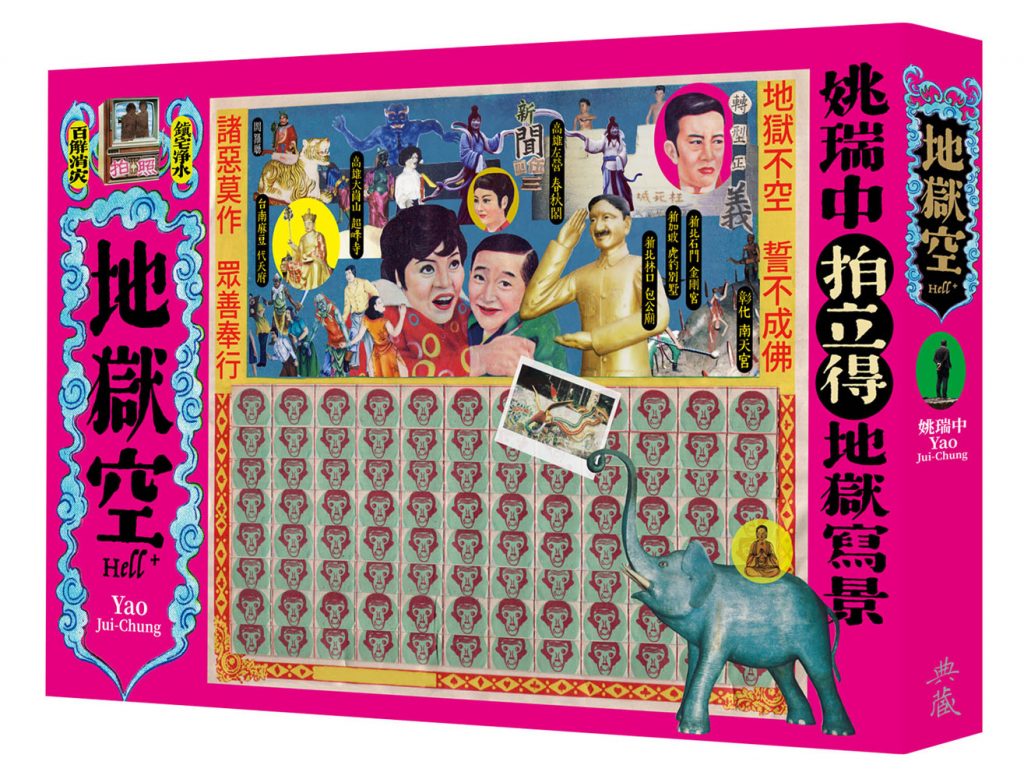
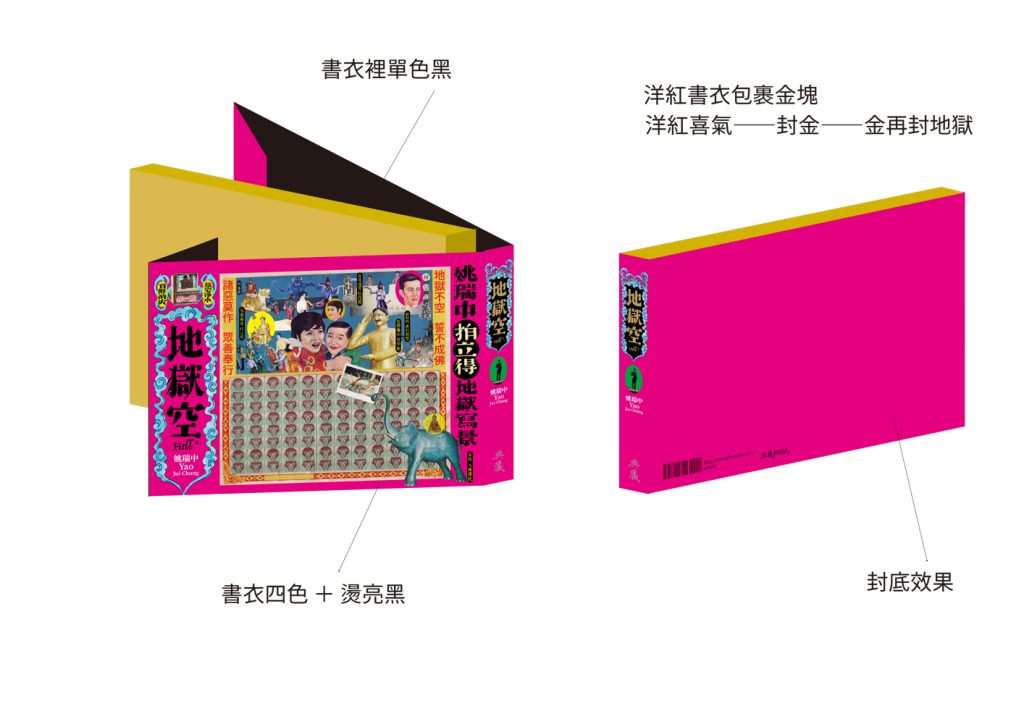

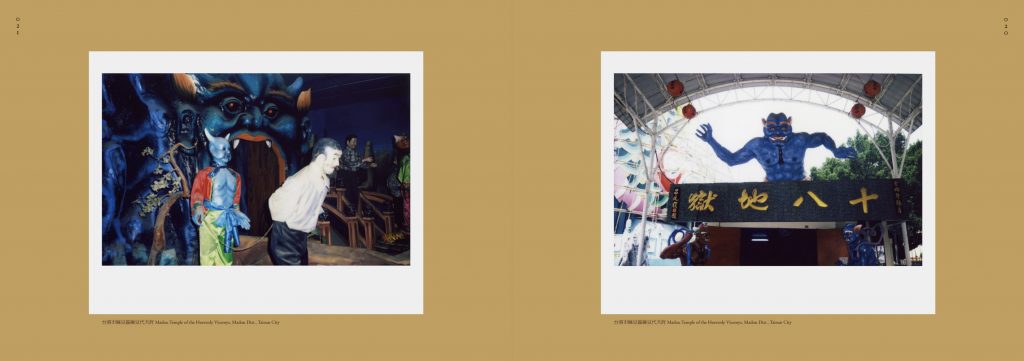
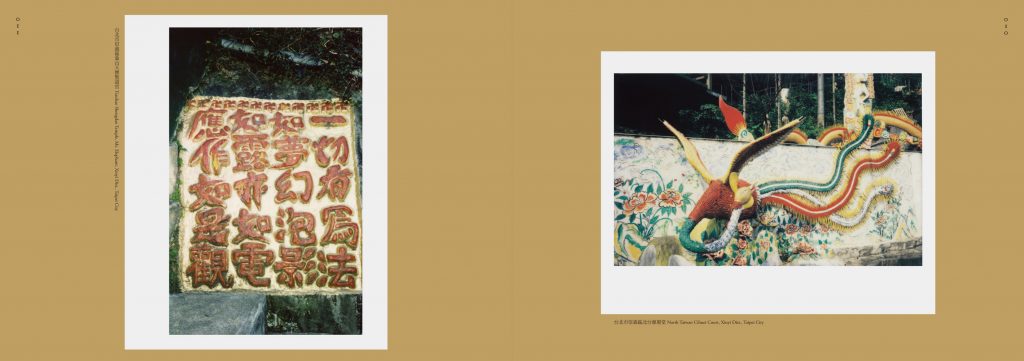
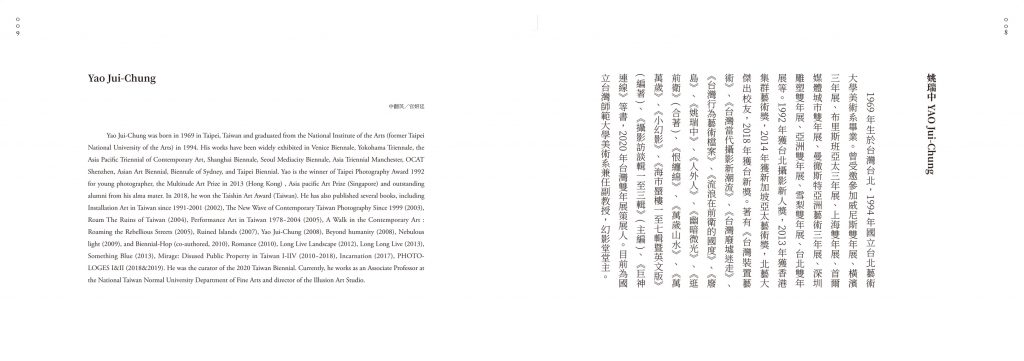
-1024x636.jpg)
書名:地獄空-姚瑞中拍立得地獄寫景
原文書名:Hell+
作者:姚瑞中
譯者:官妍廷
出版社:典藏藝術家庭股份有限公司
出版日期:2021.8.20
ISBN:978-957-9057-99-8
裝訂:平裝,附書衣,書籍三邊刷金
頁數:264
地獄空Hell+
拍立得(寶麗來)Polaroid
2018~2021
「地獄空」系列是近年走訪全台設有地獄場景宮廟並探究台灣信仰的拍攝計畫。「試著讓天堂拍得像地獄,地獄拍得像天堂。」此拍攝計畫包括台灣數個具有地獄造景、壁畫與受難圖像的宮廟或公園,拍攝多尊以道教或佛道混合信仰為主的地獄審判場景,這些雕像特別之處在於沒有西方與東方的古典雕塑感,具有乖張奇異與扭捏可愛的獨特台灣美感。
縱貫全台灣主要踏查地點包括新北市石門區金剛宮、林口區青嶺湖北文紫祥宮包公廟、彰化市南天宮、台南市麻豆代天府、嘉義縣水上鄉白人牙膏觀光工廠、高雄市阿蓮區大崗山超峰寺、高雄市左營區東南帝闕樂善社啟明堂春秋閣…等地點,也收錄了新加坡虎豹別墅。以如同田野調查般藝術概念與帶有疏離感的觀看方式,詮釋漢人常民文化中的在地美學。拍攝時以廣角大型拍立得的正面閃光與脫焦效果、化學斑點、即時顯影、發色不正常、晃動模糊、構圖歪斜、洩光……等手法,造成宛若「觀落陰」到此一遊的現場見證照,凸顯台灣民間信仰對於地獄想像的常民文化詮釋。
之所以用「地獄空」作為作品名稱,只因貪、瞋、痴、慢、疑畢竟難以根除,墮入永劫輪迴乃業障未除,過度執著外相乃至迷戀色身而錯失妙明本心,地獄自然永不空乏,地藏菩薩更永無成佛之日。若能明心見性,照見究竟空性,宛若明鏡映照塵埃,微塵卻不落鏡中,無論是極樂天堂還是無間地獄,皆來自一念之間。
Hell+
Polaroid
2018~2021
The Hell + series is a recent photographic project of Yao Jui-Chung. Yao takes a long time to visit temples around Taiwan and investigates Taiwan’s traditional beliefs. The artist tries to “make heaven like hell and hell like heaven” through his lens. For this project, Yao has been to temples or parks that feature scenes from a Taoist or Buddhist-Taoist hell with animatronic dioramas, hellish murals and images of people suffering. He photographed statues and animatronics found in these dioramas. Instead of presenting the traditional aesthetics of classical sculptures, these statues and animatronics embody an eerie beauty and quirky loveliness of Taiwan’s particular aesthetics.
Throughout Taiwan, Yao has visited the following temples and venues: Jingang Temple in Shimen District and Baogong Temple in Linkou District, New Taipei City, Nantian Temple in Changhua, Madou Daitian Temple in Tainan, Whiteman Toothpaste Tourism Factory in Shuishang Township, Chiayi, Dagangshan Chaofeng Temple in Alian District and the Spring and Autumn Pavilions of Chi Ming Palace in Zuoying District, Kaohsiung. The Haw Par Villa in Singapore is also included in this project. Yao interprets the aesthetic of Han Chinese folk culture with his field-research-like artistic approach and a detached way of viewing. Yao took the photographs with a wide-angle Polaroid with effects such as flash and out-of-focus effect, chemical stains, instantly-developing, uneven coloring, blurring, tilted horizons, and light leak effect, creating a testimony of “Guan-luo-ying” (séance). This project highlights how folk culture and beliefs shape and interpret the image of hell.
Kṣitigarbha, a bodhisattva revered in East Asian Buddhism, once made a vow not to attain Buddhahood until the hell is emptied. Yao takes “Hell +” as the title of his work since the five poisonous qualities, attachment, anger, ignorance, pride and jealousy are difficult to eradicate. If one falls into eternal reincarnation, it is because their karmic hindrance hasn’t been removed. When one is overly attached to the external appearance or obsessed with the physical body and misses one’s buddha nature, they will never get rid of falling into hell. Therefore, Kṣitigarbha will never achieve Buddhahood. If one could behold his buddha-nature with an enlightened mind, one will come to understand the ultimate voidness. Just like a clear mirror reflects the dust; however, the dust does not fall into the mirror. Whether it’s blissful heaven or infernal hell, all conditions are only shaped by a single thought.
| 尺寸 | 14.8 × 21 × 3 cm |
|---|
作者|姚瑞中(YAO Jui-Chung)
1969年生於台灣台北,1994年國立台北藝術大學美術系畢業。曾受邀參加威尼斯雙年展、橫濱三年展、布里斯班亞太三年展、上海雙年展、首爾媒體城市雙年展、曼徹斯特亞洲藝術三年展、深圳雕塑雙年展、亞洲雙年展、雪梨雙年展、台北雙年展...。1992年獲台北攝影新人獎,2013年獲香港集群藝術獎,2014年獲新加坡亞太藝術獎,北藝大傑出校友,2018年獲台新獎。著有《台灣裝置藝術》、《台灣當代攝影新潮流》、《台灣廢墟迷走》、《台灣行為藝術檔案》、《流浪在前衛的國度》、《廢島》、《姚瑞中》、《人外人》、《幽暗微光》、《逛前衛》(合著)、《恨纏綿》、《萬歲山水》、《萬萬歲》、《小幻影》、《海市蜃樓一至七輯暨英文版》(編著)、《攝影訪談輯一至三輯》(主編)、《巨神連線》等書,2020年台灣雙年展策展人。目前為國立台灣師範大學美術系兼任副教授,幻影堂堂主。






-1024x636.jpg)
書名:地獄空-姚瑞中拍立得地獄寫景
原文書名:Hell+
作者:姚瑞中
譯者:官妍廷
出版社:典藏藝術家庭股份有限公司
出版日期:2021.8.20
ISBN:978-957-9057-99-8
裝訂:平裝,附書衣,書籍三邊刷金
頁數:264
地獄空Hell+
拍立得(寶麗來)Polaroid
2018~2021
「地獄空」系列是近年走訪全台設有地獄場景宮廟並探究台灣信仰的拍攝計畫。「試著讓天堂拍得像地獄,地獄拍得像天堂。」此拍攝計畫包括台灣數個具有地獄造景、壁畫與受難圖像的宮廟或公園,拍攝多尊以道教或佛道混合信仰為主的地獄審判場景,這些雕像特別之處在於沒有西方與東方的古典雕塑感,具有乖張奇異與扭捏可愛的獨特台灣美感。
縱貫全台灣主要踏查地點包括新北市石門區金剛宮、林口區青嶺湖北文紫祥宮包公廟、彰化市南天宮、台南市麻豆代天府、嘉義縣水上鄉白人牙膏觀光工廠、高雄市阿蓮區大崗山超峰寺、高雄市左營區東南帝闕樂善社啟明堂春秋閣…等地點,也收錄了新加坡虎豹別墅。以如同田野調查般藝術概念與帶有疏離感的觀看方式,詮釋漢人常民文化中的在地美學。拍攝時以廣角大型拍立得的正面閃光與脫焦效果、化學斑點、即時顯影、發色不正常、晃動模糊、構圖歪斜、洩光……等手法,造成宛若「觀落陰」到此一遊的現場見證照,凸顯台灣民間信仰對於地獄想像的常民文化詮釋。
之所以用「地獄空」作為作品名稱,只因貪、瞋、痴、慢、疑畢竟難以根除,墮入永劫輪迴乃業障未除,過度執著外相乃至迷戀色身而錯失妙明本心,地獄自然永不空乏,地藏菩薩更永無成佛之日。若能明心見性,照見究竟空性,宛若明鏡映照塵埃,微塵卻不落鏡中,無論是極樂天堂還是無間地獄,皆來自一念之間。
Hell+
Polaroid
2018~2021
The Hell + series is a recent photographic project of Yao Jui-Chung. Yao takes a long time to visit temples around Taiwan and investigates Taiwan’s traditional beliefs. The artist tries to “make heaven like hell and hell like heaven” through his lens. For this project, Yao has been to temples or parks that feature scenes from a Taoist or Buddhist-Taoist hell with animatronic dioramas, hellish murals and images of people suffering. He photographed statues and animatronics found in these dioramas. Instead of presenting the traditional aesthetics of classical sculptures, these statues and animatronics embody an eerie beauty and quirky loveliness of Taiwan’s particular aesthetics.
Throughout Taiwan, Yao has visited the following temples and venues: Jingang Temple in Shimen District and Baogong Temple in Linkou District, New Taipei City, Nantian Temple in Changhua, Madou Daitian Temple in Tainan, Whiteman Toothpaste Tourism Factory in Shuishang Township, Chiayi, Dagangshan Chaofeng Temple in Alian District and the Spring and Autumn Pavilions of Chi Ming Palace in Zuoying District, Kaohsiung. The Haw Par Villa in Singapore is also included in this project. Yao interprets the aesthetic of Han Chinese folk culture with his field-research-like artistic approach and a detached way of viewing. Yao took the photographs with a wide-angle Polaroid with effects such as flash and out-of-focus effect, chemical stains, instantly-developing, uneven coloring, blurring, tilted horizons, and light leak effect, creating a testimony of “Guan-luo-ying” (séance). This project highlights how folk culture and beliefs shape and interpret the image of hell.
Kṣitigarbha, a bodhisattva revered in East Asian Buddhism, once made a vow not to attain Buddhahood until the hell is emptied. Yao takes “Hell +” as the title of his work since the five poisonous qualities, attachment, anger, ignorance, pride and jealousy are difficult to eradicate. If one falls into eternal reincarnation, it is because their karmic hindrance hasn’t been removed. When one is overly attached to the external appearance or obsessed with the physical body and misses one’s buddha nature, they will never get rid of falling into hell. Therefore, Kṣitigarbha will never achieve Buddhahood. If one could behold his buddha-nature with an enlightened mind, one will come to understand the ultimate voidness. Just like a clear mirror reflects the dust; however, the dust does not fall into the mirror. Whether it’s blissful heaven or infernal hell, all conditions are only shaped by a single thought.
只有註冊並且購買過商品的顧客才能撰寫評價。
作者|姚瑞中(YAO Jui-Chung)
1969年生於台灣台北,1994年國立台北藝術大學美術系畢業。曾受邀參加威尼斯雙年展、橫濱三年展、布里斯班亞太三年展、上海雙年展、首爾媒體城市雙年展、曼徹斯特亞洲藝術三年展、深圳雕塑雙年展、亞洲雙年展、雪梨雙年展、台北雙年展...。1992年獲台北攝影新人獎,2013年獲香港集群藝術獎,2014年獲新加坡亞太藝術獎,北藝大傑出校友,2018年獲台新獎。著有《台灣裝置藝術》、《台灣當代攝影新潮流》、《台灣廢墟迷走》、《台灣行為藝術檔案》、《流浪在前衛的國度》、《廢島》、《姚瑞中》、《人外人》、《幽暗微光》、《逛前衛》(合著)、《恨纏綿》、《萬歲山水》、《萬萬歲》、《小幻影》、《海市蜃樓一至七輯暨英文版》(編著)、《攝影訪談輯一至三輯》(主編)、《巨神連線》等書,2020年台灣雙年展策展人。目前為國立台灣師範大學美術系兼任副教授,幻影堂堂主。






-1024x636.jpg)
書名:地獄空-姚瑞中拍立得地獄寫景
原文書名:Hell+
作者:姚瑞中
譯者:官妍廷
出版社:典藏藝術家庭股份有限公司
出版日期:2021.8.20
ISBN:978-957-9057-99-8
裝訂:平裝,附書衣,書籍三邊刷金
頁數:264
地獄空Hell+
拍立得(寶麗來)Polaroid
2018~2021
「地獄空」系列是近年走訪全台設有地獄場景宮廟並探究台灣信仰的拍攝計畫。「試著讓天堂拍得像地獄,地獄拍得像天堂。」此拍攝計畫包括台灣數個具有地獄造景、壁畫與受難圖像的宮廟或公園,拍攝多尊以道教或佛道混合信仰為主的地獄審判場景,這些雕像特別之處在於沒有西方與東方的古典雕塑感,具有乖張奇異與扭捏可愛的獨特台灣美感。
縱貫全台灣主要踏查地點包括新北市石門區金剛宮、林口區青嶺湖北文紫祥宮包公廟、彰化市南天宮、台南市麻豆代天府、嘉義縣水上鄉白人牙膏觀光工廠、高雄市阿蓮區大崗山超峰寺、高雄市左營區東南帝闕樂善社啟明堂春秋閣…等地點,也收錄了新加坡虎豹別墅。以如同田野調查般藝術概念與帶有疏離感的觀看方式,詮釋漢人常民文化中的在地美學。拍攝時以廣角大型拍立得的正面閃光與脫焦效果、化學斑點、即時顯影、發色不正常、晃動模糊、構圖歪斜、洩光……等手法,造成宛若「觀落陰」到此一遊的現場見證照,凸顯台灣民間信仰對於地獄想像的常民文化詮釋。
之所以用「地獄空」作為作品名稱,只因貪、瞋、痴、慢、疑畢竟難以根除,墮入永劫輪迴乃業障未除,過度執著外相乃至迷戀色身而錯失妙明本心,地獄自然永不空乏,地藏菩薩更永無成佛之日。若能明心見性,照見究竟空性,宛若明鏡映照塵埃,微塵卻不落鏡中,無論是極樂天堂還是無間地獄,皆來自一念之間。
Hell+
Polaroid
2018~2021
The Hell + series is a recent photographic project of Yao Jui-Chung. Yao takes a long time to visit temples around Taiwan and investigates Taiwan’s traditional beliefs. The artist tries to “make heaven like hell and hell like heaven” through his lens. For this project, Yao has been to temples or parks that feature scenes from a Taoist or Buddhist-Taoist hell with animatronic dioramas, hellish murals and images of people suffering. He photographed statues and animatronics found in these dioramas. Instead of presenting the traditional aesthetics of classical sculptures, these statues and animatronics embody an eerie beauty and quirky loveliness of Taiwan’s particular aesthetics.
Throughout Taiwan, Yao has visited the following temples and venues: Jingang Temple in Shimen District and Baogong Temple in Linkou District, New Taipei City, Nantian Temple in Changhua, Madou Daitian Temple in Tainan, Whiteman Toothpaste Tourism Factory in Shuishang Township, Chiayi, Dagangshan Chaofeng Temple in Alian District and the Spring and Autumn Pavilions of Chi Ming Palace in Zuoying District, Kaohsiung. The Haw Par Villa in Singapore is also included in this project. Yao interprets the aesthetic of Han Chinese folk culture with his field-research-like artistic approach and a detached way of viewing. Yao took the photographs with a wide-angle Polaroid with effects such as flash and out-of-focus effect, chemical stains, instantly-developing, uneven coloring, blurring, tilted horizons, and light leak effect, creating a testimony of “Guan-luo-ying” (séance). This project highlights how folk culture and beliefs shape and interpret the image of hell.
Kṣitigarbha, a bodhisattva revered in East Asian Buddhism, once made a vow not to attain Buddhahood until the hell is emptied. Yao takes “Hell +” as the title of his work since the five poisonous qualities, attachment, anger, ignorance, pride and jealousy are difficult to eradicate. If one falls into eternal reincarnation, it is because their karmic hindrance hasn’t been removed. When one is overly attached to the external appearance or obsessed with the physical body and misses one’s buddha nature, they will never get rid of falling into hell. Therefore, Kṣitigarbha will never achieve Buddhahood. If one could behold his buddha-nature with an enlightened mind, one will come to understand the ultimate voidness. Just like a clear mirror reflects the dust; however, the dust does not fall into the mirror. Whether it’s blissful heaven or infernal hell, all conditions are only shaped by a single thought.
打破「這個我也能拍」的迷思,進入攝影藝術市場必備專書!
照片真的有價值嗎? 為什麼一張照片可以創下超過100萬美元的拍賣紀錄? 為什麼世界各地的博物館、美術館都開始建立攝影典藏? 攝影如何在藝術市場成為一股重要的勢力?它又是如何運作及發展?
從五官、表情解讀日本最著名佛像及其時代人心與美意識…
本書從人類的眉、眼、鼻、耳、口的大小、形狀、配置,以及臉部肌肉牽動產生的表情,觀察日本最具代表性的佛像,捕捉臉部的特徵,探究佛像形姿的時代變遷。
趙無極連年制霸、蘇軾《木石圖》躍居古書畫龍頭、乾隆御製琺瑯彩碗竄升億元關……,回顧2018年拍賣,熱潮雖較往年稍降,整體表現依然亮眼,「拍賣大典」一舉囊括重點拍品,幫助藏家輕鬆掌握下一波趨勢脈絡。
揭開21世紀藝術市場繁榮背後的黑暗面
藝術市場正上演著一齣權謀宮鬥的心計戲碼,資本家、藝術家、藝術經紀人、畫廊、拍賣公司、藏家……暗自角力又聯手為藝術市場帶來爆炸性的蓬勃發展,但隨之而來的卻是檯面下種種暗黑交易一一曝光。
何謂漫畫?讓您一覽日本、美國、歐州國際三大漫畫潮流
本圖錄收錄參與展覽之漫畫藝術家作品與相關文章,藝術家有尼古拉.德魁西、馬克安瑞.馬修、艾瑞克.利倍舉、伯納.伊斯列、荒木飛呂彥、克里斯.杜利安、大衛.普多姆、艾提安.達文多、恩奇.畢拉、菲立浦.度比&方陸惠、谷口治郎、常勝、61chi、小莊、簡嘉誠、TK章世炘、阿推、麥仁杰等19位。
《2015文物拍賣大典》是當今拍賣市場上,資料最豐富的工具書。本書收錄港台、大陸、歐美各大拍賣公司2014年春秋兩季的拍賣精品,分門別類為讀者完整呈現八大類五千多筆拍品精美圖文紀錄。

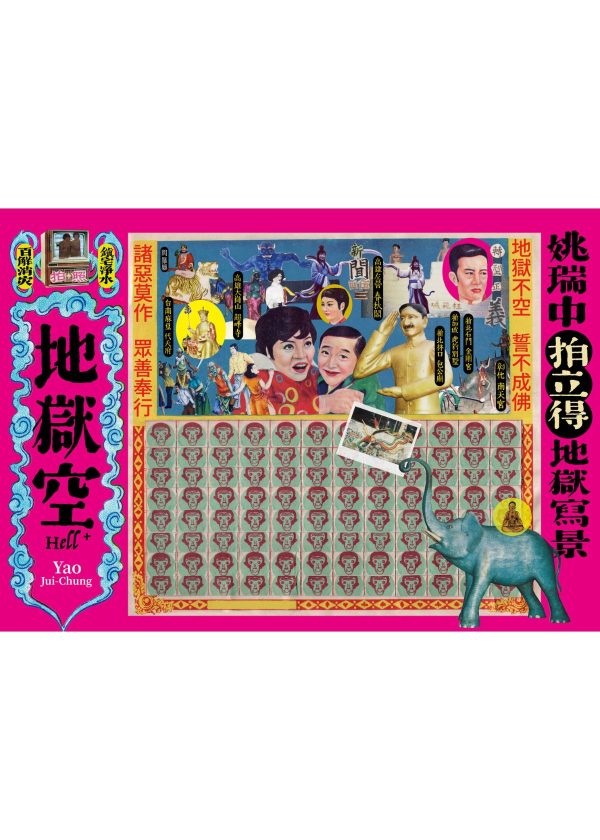
商品評價
目前沒有評價。